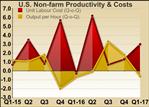
A report released by the Labor Department on Thursday showed an unexpected drop in U.S. labor productivity in the first quarter along with a bigger than expected jump in unit labor costs.
The Labor Department said productivity fell by 0.6 percent in the first quarter after surging up by a revised 1.8 percent in the fourth quarter.
Economists had expected productivity to come in unchanged compared to the 1.3 percent jump that had been reported for the previous quarter.
The unexpected drop in productivity, a measure of output per hour, came as output climbed by 1.0 percent but hours worked jumped by 1.6 percent.
The productivity growth in the fourth quarter came as output soared by 2.7 percent compared to the 1.0 percent increase in hours worked.
Meanwhile, the report said unit labor costs spiked by 3.0 percent in the first quarter following a revised 1.3 percent increase in the fourth quarter.
Unit labor costs had been expected to climb by 2.5 percent compared to the 1.7 percent advance that had been reported for the previous quarter.
The bigger than expected increase in labor costs came as hourly compensation jumped by 2.4 percent in the first quarter after soaring by 3.1 percent in the fourth quarter.
Meanwhile, real hourly compensation, which takes changes in consumer prices into account, fell by 0.8 percent in the first quarter after coming in unchanged in the previous quarter.
Compared to the same quarter a year ago, productivity was up by 1.1 percent in the first quarter, as output climbed by 2.4 percent and hours worked increased by 1.3 percent.
Unit labor costs were up by 2.8 percent year-over-year in the first quarter amid a 3.9 percent spike in hourly compensation.
by RTT Staff Writer
For comments and feedback: editorial@rttnews.com
Economic News
What parts of the world are seeing the best (and worst) economic performances lately? Click here to check out our Econ Scorecard and find out! See up-to-the-moment rankings for the best and worst performers in GDP, unemployment rate, inflation and much more.
